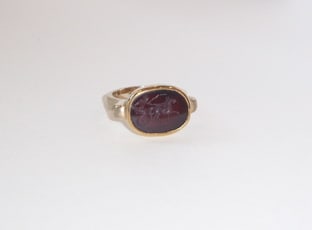Gold Ring Featuring a Classical Revival Carnelian Intaglio of a Chariot, 18th Century CE
Carnelian, Gold
FJ.6786
This Gorgeous Intaglio Has Been Mounted in a Modern 18 Karat Gold Rin The art of glyptics, or carving on colored precious stones, is probably one of the oldest known...
This Gorgeous Intaglio Has Been Mounted in a Modern 18 Karat Gold Rin
The art of glyptics, or carving on colored precious stones, is probably one of the oldest known to humanity. Intaglios, gems with an incised design, were made as early as the fourth and third millennia B.C. in Mesopotamia and the Aegean Islands. The exhibit a virtuosity of execution that suggests an old and stable tradition rooted in the earliest centuries. The tools required for carving gems were simple: a wheel with a belt-drive and a set of drills. Abrasives were necessary since the minerals used were too hard for a metal edge. A special difficulty of engraving intaglios, aside from their miniature size, was that the master had to work with a mirror-image in mind.
The Classical Revival was a phenomenon that swept through Europe in the 18th and 19th Centuries. A new appreciation for antiquity and ancient art forms was fostered by discoveries in the nascent scientific field of archaeology. Perhaps the Classical Revival also reveals a latent longing towards the Arcadian lifestyles of yesterday abandoned as Europe became rapidly industrialized and increasingly urbanized. Gazing upon this intaglio, one can almost hear sound of the stampeding hooves of the horse crashing onto the rough ground. Chariot races were one of the most popular spectator sports during the ancient Roman Empire. However, no mere charioteer holds the reigns of this horse; instead, the driver is winged Victoria, the goddess of victory. This intaglio imitates similar ancient examples that were most likely the prized possession of champion charioteers bestowed upon them by the emperor or other wealthy, admiring fans. Moreover, the chariot in ancient times was a symbol of might and victory, be it in war or contest. This beautiful seal, mounted in a gorgeous modern gold ring, celebrates antiquity as reinterpreted by the Victorian era. May the lucky individual who wears this ring have Victoria as his driver as well.
The art of glyptics, or carving on colored precious stones, is probably one of the oldest known to humanity. Intaglios, gems with an incised design, were made as early as the fourth and third millennia B.C. in Mesopotamia and the Aegean Islands. The exhibit a virtuosity of execution that suggests an old and stable tradition rooted in the earliest centuries. The tools required for carving gems were simple: a wheel with a belt-drive and a set of drills. Abrasives were necessary since the minerals used were too hard for a metal edge. A special difficulty of engraving intaglios, aside from their miniature size, was that the master had to work with a mirror-image in mind.
The Classical Revival was a phenomenon that swept through Europe in the 18th and 19th Centuries. A new appreciation for antiquity and ancient art forms was fostered by discoveries in the nascent scientific field of archaeology. Perhaps the Classical Revival also reveals a latent longing towards the Arcadian lifestyles of yesterday abandoned as Europe became rapidly industrialized and increasingly urbanized. Gazing upon this intaglio, one can almost hear sound of the stampeding hooves of the horse crashing onto the rough ground. Chariot races were one of the most popular spectator sports during the ancient Roman Empire. However, no mere charioteer holds the reigns of this horse; instead, the driver is winged Victoria, the goddess of victory. This intaglio imitates similar ancient examples that were most likely the prized possession of champion charioteers bestowed upon them by the emperor or other wealthy, admiring fans. Moreover, the chariot in ancient times was a symbol of might and victory, be it in war or contest. This beautiful seal, mounted in a gorgeous modern gold ring, celebrates antiquity as reinterpreted by the Victorian era. May the lucky individual who wears this ring have Victoria as his driver as well.



